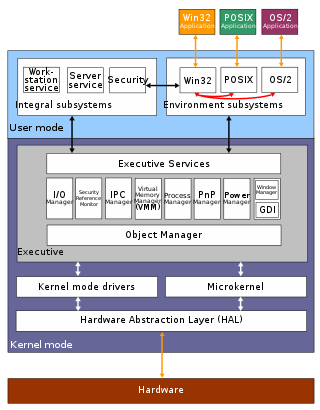In computing, Common Gateway Interface (CGI) is an interface specification that enables web servers to execute an external program to process HTTP or HTTPS user requests.

The Windows API, informally WinAPI, is the foundational application programming interface (API) that allows a computer program to access the features of the Microsoft Windows operating system in which the program is running.
In object-oriented programming, the command pattern is a behavioral design pattern in which an object is used to encapsulate all information needed to perform an action or trigger an event at a later time. This information includes the method name, the object that owns the method and values for the method parameters.
The C preprocessor is the macro preprocessor for several computer programming languages, such as C, Objective-C, C++, and a variety of Fortran languages. The preprocessor provides inclusion of header files, macro expansions, conditional compilation, and line control.
The Web Server Gateway Interface is a simple calling convention for web servers to forward requests to web applications or frameworks written in the Python programming language. The current version of WSGI, version 1.0.1, is specified in Python Enhancement Proposal (PEP) 3333.
In computer programming, an entry point is the place in a program where the execution of a program begins, and where the program has access to command line arguments.
In software engineering, inversion of control (IoC) is a design pattern in which custom-written portions of a computer program receive the flow of control from a generic framework. The term "inversion" is historical: a software architecture with this design "inverts" control as compared to procedural programming. In procedural programming, a program's custom code calls reusable libraries to take care of generic tasks, but with inversion of control, it is the framework that calls the custom code.
The Perl Object Environment (POE) is a library of Perl modules written in the Perl programming language by Rocco Caputo et al.
In computing, ioctl is a system call for device-specific input/output operations and other operations which cannot be expressed by regular file semantics. It takes a parameter specifying a request code; the effect of a call depends completely on the request code. Request codes are often device-specific. For instance, a CD-ROM device driver which can instruct a physical device to eject a disc would provide an ioctl request code to do so. Device-independent request codes are sometimes used to give userspace access to kernel functions which are only used by core system software or still under development.
The Spring Framework is an application framework and inversion of control container for the Java platform. The framework's core features can be used by any Java application, but there are extensions for building web applications on top of the Java EE platform. The framework does not impose any specific programming model.. The framework has become popular in the Java community as an addition to the Enterprise JavaBeans (EJB) model. The Spring Framework is free and open source software.
In computer programming, an anonymous function is a function definition that is not bound to an identifier. Anonymous functions are often arguments being passed to higher-order functions or used for constructing the result of a higher-order function that needs to return a function. If the function is only used once, or a limited number of times, an anonymous function may be syntactically lighter than using a named function. Anonymous functions are ubiquitous in functional programming languages and other languages with first-class functions, where they fulfil the same role for the function type as literals do for other data types.
Web2py is an open-source web application framework written in the Python programming language. Web2py allows web developers to program dynamic web content using Python. Web2py is designed to help reduce tedious web development tasks, such as developing web forms from scratch, although a web developer may build a form from scratch if required.

Rust is a multi-paradigm, general-purpose programming language that emphasizes performance, type safety, and concurrency. It enforces memory safety—meaning that all references point to valid memory—without a garbage collector. To simultaneously enforce memory safety and prevent data races, its "borrow checker" tracks the object lifetime of all references in a program during compilation. Rust was influenced by ideas from functional programming, including immutability, higher-order functions, and algebraic data types. It is popular for systems programming.

ColdBox is a free, open-source, conventions-based, modular web application framework intended for building enterprise applications with ColdFusion (CFML) using a Hierarchical MVC approach.
Racket has been under active development as a vehicle for programming language research since the mid-1990s, and has accumulated many features over the years. This article describes and demonstrates some of these features. Note that one of Racket's main design goals is to accommodate creating new programming languages, both domain-specific languages and completely new languages. Therefore, some of the following examples are in different languages, but they are all implemented in Racket. Please refer to the main article for more information.

Yesod is a web framework based on the programming language Haskell for productive development of type-safe, representational state transfer (REST) model based, high performance web applications, developed by Michael Snoyman, et al. It is free and open-source software released under an MIT License.
FCL-Web is part of Free Pascal's Free Component Library (FCL), focusing on web (related) application development. The package helps users to develop CGI, FastCGI and embedded web server applications, as well as Apache modules. It provides units implementing HTTP(S) protocol and a somewhat low level web application framework, in the form of web modules. Some content producers are also provided. Other prominent use is to send/retrieve data from/to web services.

Nim is a general-purpose, multi-paradigm, statically typed, compiled high-level systems programming language, designed and developed by a team around Andreas Rumpf. Nim is designed to be "efficient, expressive, and elegant", supporting metaprogramming, functional, message passing, procedural, and object-oriented programming styles by providing several features such as compile time code generation, algebraic data types, a foreign function interface (FFI) with C, C++, Objective-C, and JavaScript, and supporting compiling to those same languages as intermediate representations.

Tokio is a software library for the Rust programming language. It provides a runtime and functions that enable the use of asynchronous I/O, allowing for concurrency in regards to task completion.
The Asynchronous Server Gateway Interface (ASGI) is a calling convention for web servers to forward requests to asynchronous-capable Python programming language frameworks, and applications. It is built as a successor to the Web Server Gateway Interface (WSGI).





